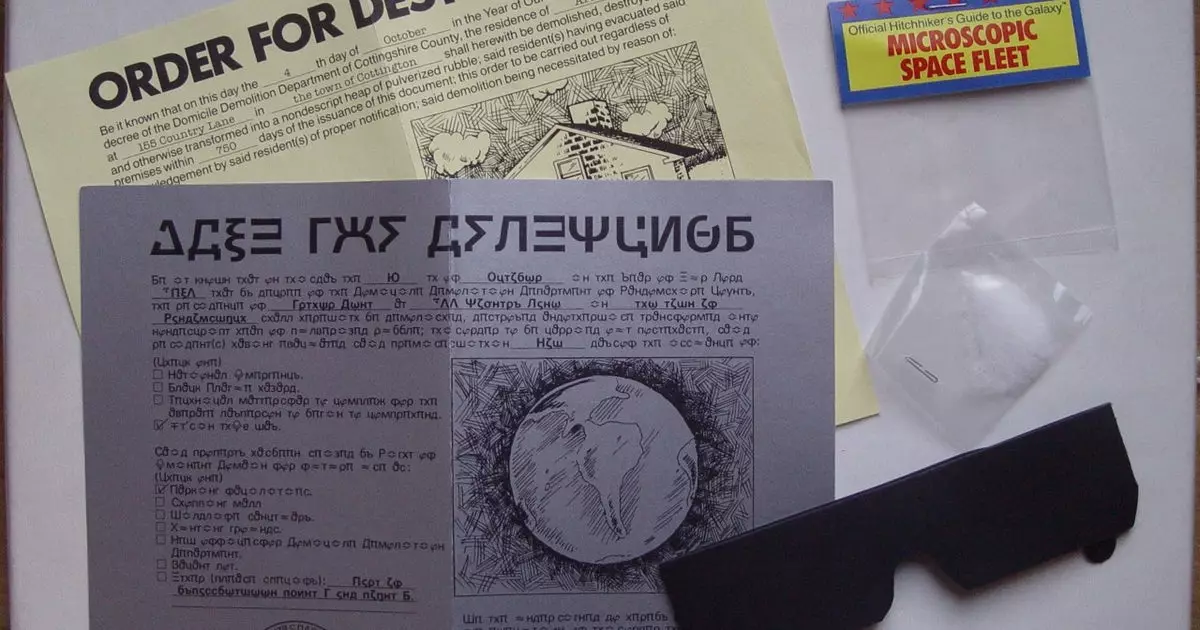In an increasingly digital era, where the pulse of video games beats to the rhythm of hyper-realism and massive franchises, it’s easy to lose sight of the small treasures that once enriched our gaming experiences. A recent exploration into the world of game ephemera—particularly from the lauded company Infocom—has reignited a conversation about the quaint charm of useless collectibles that accompany many beloved titles. Among them, the 1984 adventure game *The Hitchhiker’s Guide to the Galaxy* stands out, offering not just a game, but an experience steeped in curiosity and whimsy.
Scott Krol, a notable figure in gaming discussions and a curator of the unusual, recently noted how Infocom pioneered the inclusion of physical items—coined “feelies”—with their games. This innovative approach caught the imagination of players and collectors alike, blurring the line between the virtual experience and the tangible world. Krol’s reflections reveal a nostalgic perspective, one that resonates deeply in the hearts of many gamers who remember rifling through the contents of a flimsy envelope hoping to unveil a hidden treasure—or at times, simply a clever joke about nothing at all.
Rediscovering the Narrative Through Arthur Dent
Digging deeper into the landscapes of nostalgia, writer Victoria Regan’s reflections on Arthur Dent, the hapless protagonist of *The Hitchhiker’s Guide*, not only captures the essence of his character but also distills the emotional experience of gaming itself. Dent’s plight amidst absurdities that encompass the entire universe speaks volumes about the human condition—his struggle against the mundane is nothing short of heroic. Through Regan’s lens, we come to appreciate the beautiful contradictions within Dent’s character. In a world rife with chaos, his stoicism radiates courage, presenting a narrative that challenges our understanding of heroism.
Regan’s analysis is not just flattering; it reshapes our perception of what it means to engage with a narrative. Rather than focusing solely on combat or grand quests, she invites us to consider the quieter moments of endurance and acceptance. In many ways, Regan’s take is a reminder that narratives don’t always culminate in grand battles; sometimes they mirror the struggle of merely existing—facing the absurdities of life with a sense of dignity, which resonates with audiences both familiar and new.
The Quest for Hidden Meaning
While the intangible joys of game exploration are often overshadowed by immediate rewards and predictable outcomes in modern gaming, Regan brings to light a valuable aspect of gaming that deserves rekindling—the dedication to discovery. She speaks candidly of the motivation that drives players to push through notorious roadblocks within games, spurred by the primal urge to uncover secrets. This sentiment is precious, especially when many contemporary game releases come pre-packaged in hype-driven narratives, reducing player agency and unique experience.
In an age where players are inundated with spoilers and pre-launch content, the allure of the unknown has begun to fade. The experience of discovering a hidden element within a game without any prior knowledge fosters a unique connection between the player and the game’s narrative. Regan’s reflection reminds us that the essence of adventure games lies not just in the end goal but in the unpredictable journey that unfolds. It’s a perspective that urges a return to the roots of exploration—encouraging developers to weave layers of mystery back into their titles.
The Charm of Beautiful Uselessness
Amidst this nostalgia lies the idea of the “beautifully useless” collectible—a term that encapsulates the charm Infocom’s feelies brought to the gaming world. These small tokens of immersion invite not just collection but reflection. They serve as a gentle reminder that utility isn’t the only measure of worth; sometimes, the simplest objects hold the deepest sentimental value.
In contrast to the polished—and often expensive—statues and collectibles that dominate today’s market, the ethos of these feelies glorifies their lack of commercial viability. They stand as testaments to a time when gaming was more about the experience and less about the consumerism that often plagues it. The thrill lies not in acquiring power but in embracing the absurdity and triviality of certain artifacts—a realization that celebrates the eclectic origins of our gaming heritage.
In a world that often prioritizes financial gain over creative expression, it is refreshing to embrace the nostalgia of what is perceived as ‘tat.’ Let us not shy away from the quirky and the unconventional collectibles, as they not only tell stories but also allow us to reconnect with the joy of pure discovery.


Leave a Reply